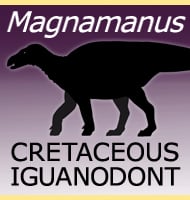Magnamanus
In Depth Magnamanus is a genus of iguanodont dinosaur that lived in Spain during the early Cretaceous. The name Magnamanus means ‘large hand’, a reference to the enlarged well developed hands that this dinosaur genus adapted, notably more so than other known iguanodonts. The first individual of Magnamanus was at the time of its naming … Read more
